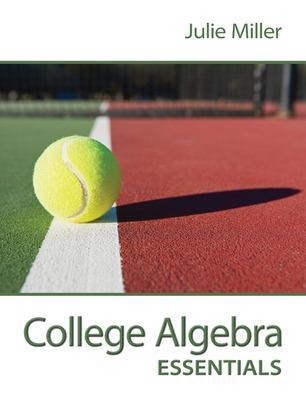
College Algebra Essentials
McGraw Hill Higher Education (Verlag)
9780078035616 (ISBN)
When Julie Miller began writing her successful developmental math series, one of her primary goals was to bridge the gap between preparatory courses and college algebra. For thousands of students, the Miller/O’Neill/Hyde (or M/O/H) series has provided a solid foundation in developmental mathematics. With the Miller College Algebra series, Julie has carried forward her clear, concise writing style; highly effective pedagogical features; and complete author-created technological package to students in this course area. The main objectives of the college algebra series are three-fold:-Provide students with a clear and logical presentation of -the basic concepts that will prepare them for continued study in mathematics.-Help students develop logical thinking and problem-solving skills that will benefit them in all aspects of life. -Motivate students by demonstrating the significance of mathematics in their lives through practical applications.
Julie Miller is from Daytona State College, where she has taught developmental and upper-level mathematics courses for 20 years. Prior to her work at Daytona State College, she worked as a software engineer for General Electric in the area of flight and radar simulation. Julie earned a bachelor of science in applied mathematics from Union College in Schenectady, New York, and a master of science in mathematics from the University of Florida. In addition to this textbook, she has authored several course supplements for college algebra, trigonometry, and precalculus, as well as several short works of fiction and nonfiction for young readers. My father is a medical researcher, and I got hooked on math and science when I was young and would visit his laboratory. I can remember using graph paper to plot data points for his experiments and doing simple calculations. He would then tell me what the peaks and features in the graph meant in the context of his experiment. I think that applications and hands-on experience made math come alive for me and I’d like to see math come alive for my students.
College Algebra Essentials 1eChapter R: Review of PrerequisitesSection R.1 Sets and the Real Number LineSection R.2 Models, Algebraic Expressions, and Properties of Real NumbersSection R.3 Integer Exponents and Scientific NotationSection R.4 Rational Exponents and RadicalsSection R.5 Polynomials and Multiplication of RadicalsProblem Recognition Exercises: Simplifying Algebraic Expressions
Section R.6 FactoringSection R.7 Rational Expressions and More Operations on RadicalsChapter 1: Equations and InequalitiesSection 1.1 Linear Equations and Rational EquationsSection 1.2 Applications and Modeling with Linear EquationsSection 1.3 Complex NumbersSection 1.4 Quadratic EquationsProblem Recognition Exercises: Simplifying Expressions versus Solving Equations
Section 1.5 Applications of Quadratic EquationsSection 1.6 More Equations and ApplicationsSection 1.7 Linear Inequalities and Compound InequalitiesSection 1.8 Absolute Value Equations and InequalitiesProblem Recognition Exercises: Recognizing and Solving Equations and Inequalities
Chapter 2: Functions and GraphsSection 2.1 The Rectangular Coordinate System and Graphing UtilitiesSection 2.2 CirclesSection 2.3 Functions and RelationsSection 2.4 Linear Equations in Two Variables and Linear FunctionsSection 2.5 Applications of Linear Equations and ModelingProblem Recognition Exercises: Comparing Graphs of Equations
Section 2.6 Transformation of GraphsSection 2.7 Analyzing Graphs of Functions and Piecewise-Defined FunctionsSection 2.8 The Algebra of FunctionsChapter 3: Polynomial and Rational FunctionsSection 3.1 Quadratic Functions and ApplicationsSection 3.2 Introduction to Polynomial FunctionsSection 3.3 Division of Polynomials and the Remainder and Factor TheoremsSection 3.4 Zeros of PolynomialsSection 3.5 Rational FunctionsProblem Recognition Exercises: Polynomial and Rational Functions
Section 3.6 Polynomial and Rational InequalitiesProblem Recognition Exercises: Solving Equations and Inequalities
Section 3.7 VariationChapter 4: Exponential and Logarithmic FunctionsSection 4.1 Inverse FunctionsSection 4.2 Exponential FunctionsSection 4.3 Logarithmic FunctionsProblem Recognition Exercises: Analyzing Functions
Section 4.4 Properties of LogarithmsSection 4.5 Exponential and Logarithmic EquationsSection 4.6 Modeling with Exponential and Logarithmic FunctionsChapter 5: Systems of Equations and InequalitiesSection 5.1 Systems of Linear Equations in Two Variables and ApplicationsSection 5.2 Systems of Linear Equations in Three Variables and ApplicationsSection 5.3 Partial Fraction DecompositionSection 5.4 Systems of Nonlinear Equations in Two VariablesSection 5.5 Inequalities and Systems of Inequalities in Two VariablesProblem Recognition Exercises: Equations and Inequalities in Two Variables
Section 5.6 Linear Programming
| Erscheint lt. Verlag | 16.2.2013 |
|---|---|
| Zusatzinfo | Illustrations |
| Verlagsort | London |
| Sprache | englisch |
| Maße | 218 x 282 mm |
| Gewicht | 1563 g |
| Themenwelt | Mathematik / Informatik ► Mathematik ► Algebra |
| ISBN-13 | 9780078035616 / 9780078035616 |
| Zustand | Neuware |
| Informationen gemäß Produktsicherheitsverordnung (GPSR) | |
| Haben Sie eine Frage zum Produkt? |
aus dem Bereich


